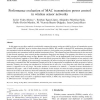IOR
2008
13 years 11 months ago
2008
Wireless sensor networks pose numerous fundamental coordination problems. For instance, in a number of application domains including homeland security, environmental monitoring an...
CN
2007
13 years 11 months ago
2007
This paper describes BiSNET (Biologically-inspired architecture for Sensor NETworks), a middleware architecture that addresses several key issues in multi-modal wireless sensor ne...
CN
2007
13 years 11 months ago
2007
In this paper we provide a method to analytically compute the energy saving provided by the use of transmission power control (TPC) at the MAC layer in wireless sensor networks (W...
IJSNET
2008
13 years 11 months ago
2008
: The IEEE 802.15.4 and Zigbee are protocols aimed at low-duty and low-power wireless sensor networks. Continuously monitoring applications such as applications of structural healt...
IJSNET
2008
13 years 11 months ago
2008
Delivering sensed data to the sink reliably in sensor networks calls for a scalable, energy-efficient, and error-resilient routing solution. In this paper, a reliable energy-effic...
CORR
2006
Springer
13 years 11 months ago
2006
Springer
Time synchronization is an important aspect of sensor network operation. However, it is well known that synchronization error accumulates over multiple hops. This presents a challe...
COMCOM
2006
13 years 11 months ago
2006
Due to limited energy capacity of batteries, the function lifetime of sensor networks in general is longer than the operational lifetime of single nodes. Therefore, to keep the ne...
COMCOM
2006
13 years 11 months ago
2006
In wireless sensor networks (WSNs), when a stimulus or event is detected within a particular region, data reports from the neighboring sensor nodes (sources) are sent to the sink ...
COMCOM
2006
13 years 11 months ago
2006
Wireless sensor networks are poised to revolutionize our abilities in sensing and controlling our environment. Power conservation is a primary research concern for these networks....
COMCOM
2006
13 years 11 months ago
2006
A number of routing protocols [1] have been proposed for wireless sensor networks in recent years. Considering energy-efficiency as the primary objective, most of routing protocol...

